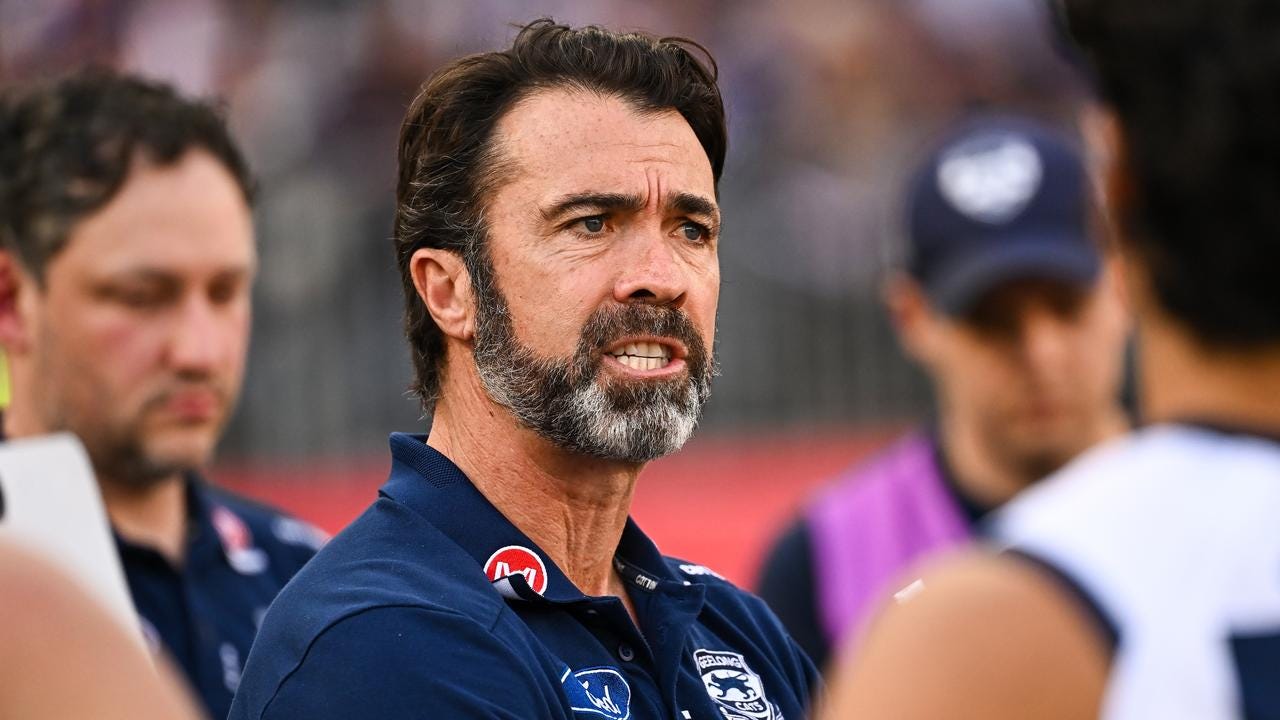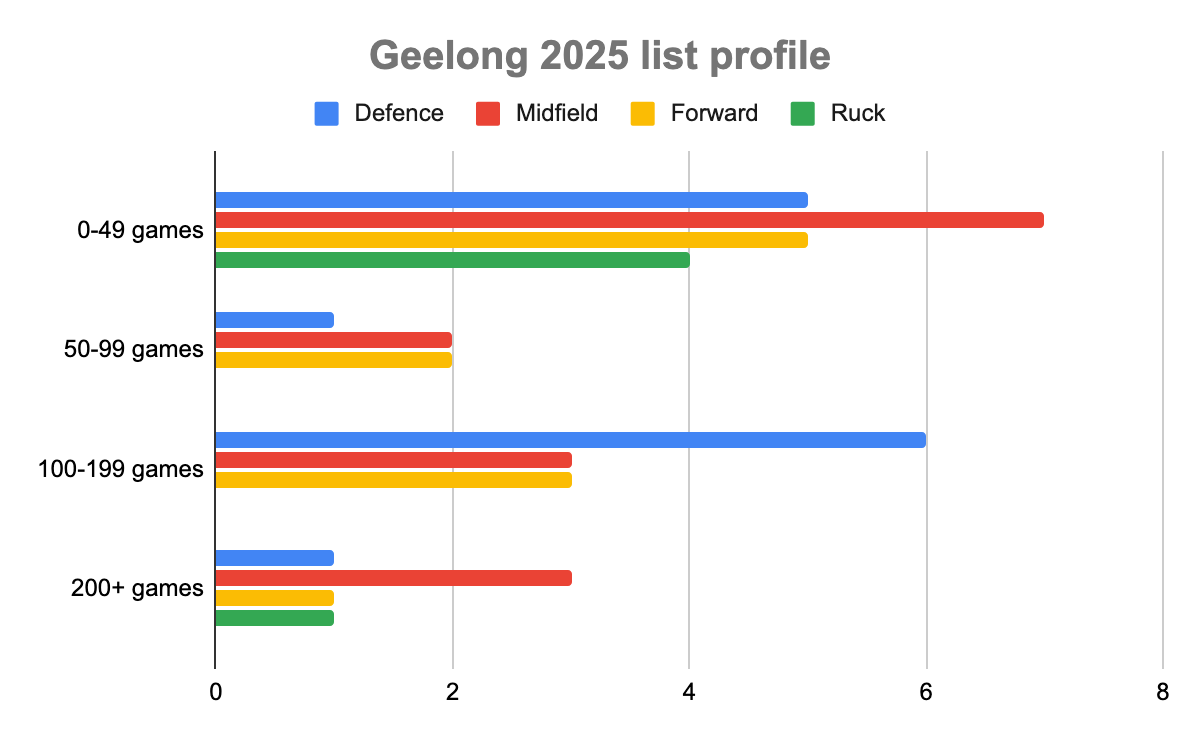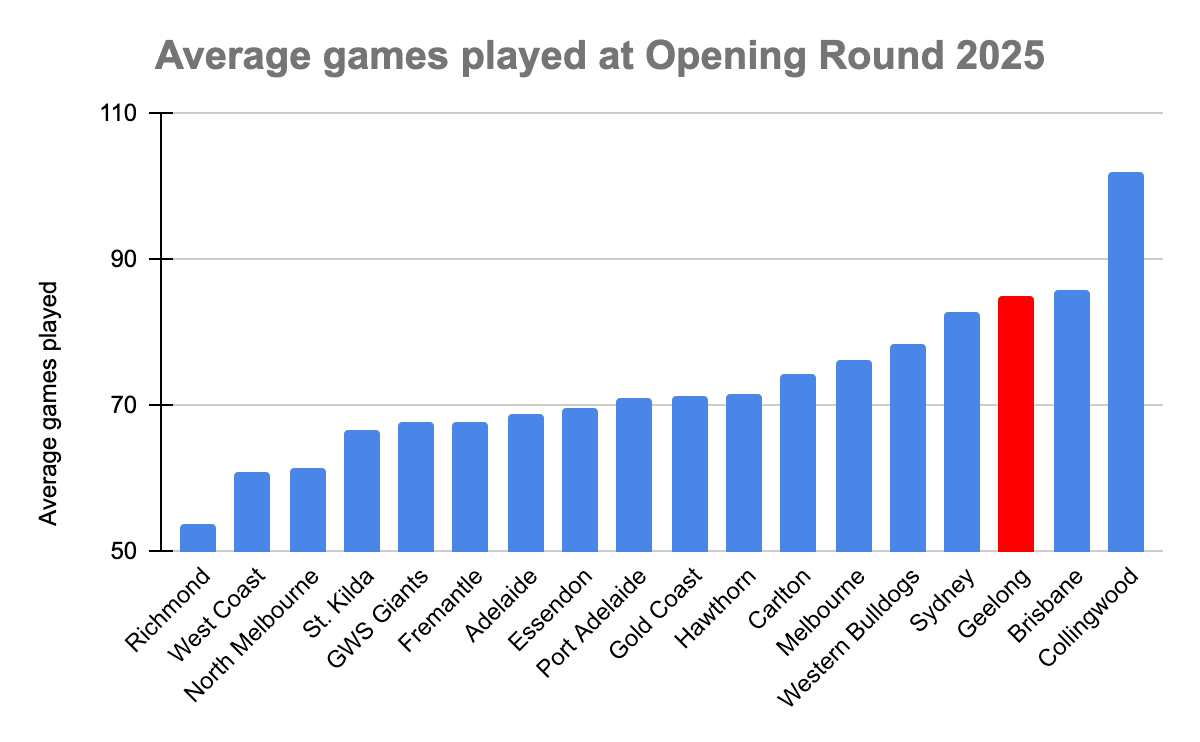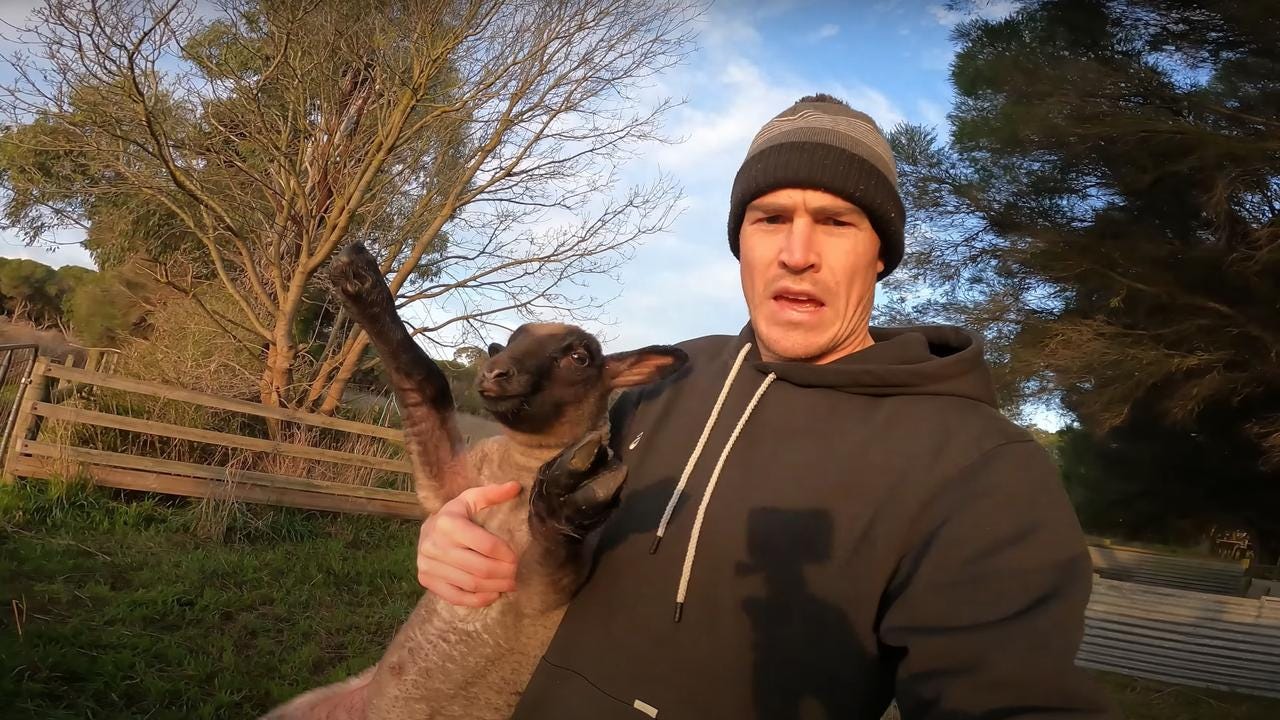2025 AFL Season Previews: Geelong
Scott's Cat is a thought experiment where the cat is winning and rebuilding at the same time.
Preview number seven takes me to the salubrious surrounds of Geelong.
2024 ladder position: 3rd (15 wins, 8 losses)
2024 best-and-fairest: Max Holmes
Senior coach: Chris Scott
Story of the season
Chris Scott played all the hits. The Cats rebounded from the rarest thing in footy – missing finals – by unfussily winning their first seven games of the season, finishing in the top four despite most metrics not having them quite that high, obliterating Port Adelaide in a qualifying final, before falling just short against the big cat eventual Premiers. But although from the outside this looked like it could have been every second Geelong season since about 2006, 2024 is better understood as the year when the Cats’ cohort of younger players (yes, they have them, and they’re good!) assumed the burden of responsibility for driving the team forward. The old guys played their parts. But so did Max Holmes, Tanner Bruhn, Gryan Miers, Ollie Dempsey and Lawson Humphries, in the process ensuring that for as long as they have the best recruiters and probably the best coach in the caper, they’re going nowhere.
Summary of game style
Remember when Geelong used to kick it around, patiently probing for gaps in the opposition’s defensive zone? They don’t do that anymore. Instead, like a parent that’s given up trying to prevent their toddler from throwing food around, they’ve embraced the chaos. In preparation for my Brisbane season preview, I developed a rough and ready “control index” which took the average number of marks a team took per game and subtracted the average number of ground balls they won. The Lions were number one by a mile, averaging 20 more marks than ground ball gets. The Cats were 18th, recording approximately seven and a half more ground ball gets than marks per game. They now resemble their great adversary from the 2017-2020 era, Damien Hardwick’s Richmond.
Geelong bend chaos to their will in every phase of the game. A seemingly inexhaustible supply of tall blonde dudes wins the ball from the opposition in the air (Geelong were fourth for intercept marks) and on the ground (second for intercept possessions, behind only Gold Coast). A battery of small forwards converts those ground balls and handball receives into pinpoint forward deliveries. But despite having several distinct ball movement patterns, the Cats are most interested in speed. In 2024, they gained the most metres – both in absolute terms and per disposal – and required the fewest possessions to transition from their defensive 50 to forward 50. That directness, based on the idea that you’re more likely to catch opposition defences out of position when you win possession back immediately after conceding it, is a huge factor in Geelong’s attacking potency.
It’s not all about turnovers, though. Or rather, there’s another layer which helps explain why Geelong are so proficient at generating them. The Cats had more ruck contests in their games than any other side. In other words, they’re very stoppage-heavy. But Mateo, I hear you ask, isn’t Geelong’s midfield bad? Don’t they lose a heap of clearances? Well, it’s true that no side gave up more clearances. But the kicker is that, despite playing a stoppage-heavy style, Geelong don’t actually care all that much about the direct outcomes of stoppages. Yes, folks, that’s right – the post-clearance game. Geelong care more about what happens after the conclusion of the stoppage than during it. Scott will often take a player away from a stoppage and instead drop him a kick behind play, content for Geelong’s opponents to temporarily gain territory if it means their defence can be pulled out of shape. It feels like more of Geelong’s games are played in the two 50-metre arcs than any other side’s. It’s a sign of the trust Scott has in his side’s defensive structures, the quality of its personnel, and a ball movement scheme that often catches sides before they’re set. No wonder they ranked first for scores from the back half in 2024.
List changes
In:
Jay Polkinghorne (2024 National Draft, pick #44)
Jacob Molier (2024 National Draft, pick #52)
Lennox Hofmann (2024 National Draft, pick #66)
Keighton Matofai-Forbes (2024 National Draft, pick #69)
Xavier Ivisic (Rookie Draft)
Joe Pike (Rookie Draft)
Patrick Retschko (Rookie Draft)
Cillian Burke (Category B rookie)
Jack Martin (delisted free agent)
Bailey Smith (trade – Western Bulldogs)
Out:
Phoenix Foster (delisted)
Joe Furphy (delisted)
Mitch Hardie (delisted)
Emerson Jeka (delisted)
Oscar Murdoch (delisted)
James Willis (delisted)
Brandan Parfitt (delisted)
Gary Rohan (delisted)
Tom Hawkins (retired)
Zach Tuohy (retired)
List profile
Number of top-10 draft picks: four (T-16th)
Average age at Opening Round: 25.2 (5th)
Average number of games played: 85 (third)
Ten in, ten out. There was a lot of list turnover at the Cattery, with eight delistings and the emotional retirements of Tom Hawkins and Zach Tuohy. As is often the case, Geelong entered the draft late, content to exchange their first pick for a trade target and confident in their recruiters’ ability to find good value further down the order. I have no insights to offer about the Cats’ new draftees beyond what I’ve already read on sites like RookieMe Central. But I like the strategy. Every pick in a draft is like flipping over a shell. Sometimes, there’s a pearl underneath. Other times, just a shell. The later in the draft, the higher the chance you have of just finding a shell. But the best way to maximise the chances of finding pearls like Gryan Miers or Lawson Humphries is by… flipping lots of shells.
Clearly, the highest-profile addition to the Geelong list is Bailey Smith. Smith is a fascinating prospect – a flying winger/outside midfielder with a high media profile who’ll be coming back from a serious knee injury to a new club and possibly a new role. I suspect that the year off, combined with fatigue surrounding the will-he-won’t-he-obviously-he-will trade saga, has led some people to forget just how impressive his first three years were. His kicks might not always hit the target, but hey, neither do Patrick Dangerfield’s. And besides, The Cats like chaos these days.
The defence remains an area of strength. Tom Stewart is still the ace, aggressively intercepting opposition entries and quickly initiating score launches. Sam de Koning, Jack Henry and Jake Kolodjashnij are reliable key defensive options, even if the latter is closer to the end than the beginning. Zach Guthrie, once the resident whipping boy, has emerged as a really solid option across half-back, while Lawson Humphries has looked like a 200-game veteran since his debut game, offering a cool head and precise distribution off both feet.
Probably the biggest question for both Geelong’s defence and midfield in 2024 surrounds the role of Max Holmes. The reigning best-and-fairest winner tends to excel in any role, but given the emergence of Humphries and the addition of Smith, I’d expect to see him given a mixed inside/outside midfield role, with plenty of centre bounce attendances and time on a wing. The other wing will belong to the Rising Star winner from 2024, Ollie Dempsey. Inside, Chris Scott will continue with his horses-for-courses approach, inserting different combinations to pose different questions to the opposition. Expect Dangerfield and Bruhn to figure more prominently, with Smith and Holmes as mostly outside options. Geelong’s midfield is by no means the best in the game, but what makes it slightly difficult for outsiders to judge is that, as I discussed in detail above, Scott doesn’t place a high priority on winning clearances, instead using stoppages as a chance to establish structures around the ball.
The forward line will have a different appearance without Tom Hawkins, although in truth he was a supporting character last season anyway. There’s not much new to say about the key forwards. Jeremy Cameron remains one of the league’s best players, Ollie Henry a very good finisher, and Shannon Neale is also a guy (who Geelong will really want to take the next step soon). But it’s the battery of small forwards that are the nervous system of this Geelong team. Gryan Miers and Brad Close are the playmaking half-forwards, Stengle is a superb traditional small, while Shaun Mannagh took to an unusual playmaking/goalkicking forward cum auxiliary midfielder role in his first season of AFL like a duck to water. All four can score, facilitate, push up to stoppages, and create.
Line rankings
Defence: Above Average
Midfield: Average
Forward: Elite
Ruck: Average
The case for optimism
Why wouldn’t Geelong supporters be optimistic? They support a club with an unrivalled track record of defying gravity in the AFL, constantly turning over their list while luring the big-name trade targets and free agents to keep them at the pointy end. To that end – they’ve just added Bailey Smith to a side which was leading a prelim, against the eventual Premiers, with fewer than five minutes on the clock. If you’re already almost good enough, and you make your team a little better, nice things tend to follow. The presence of Bailey Smith might well have been enough to flip the result of last year’s prelim.
The Cats dance on air because they have possibly the competition’s smartest coach, a best-in-class recruiting team, the lure of a country lifestyle with a reasonable commute to the big smoke, and of course because of [redacted]. All these elements work together in near-perfect harmony. I’m writing this the morning after the Indigenous All-Stars played against Fremantle (great concept, by the way, hope it becomes at least a semi-permanent fixture). No one except for observant Geelong fans, Western Australian draft-watchers and WAFL diehards had heard of Lawson Humphres a year ago. But, despite sharing the field with some of the game’s brightest stars, he didn’t look at all out of place. He, Dempsey, Stengle, and Miers all make significant on-field contributions, and all were recruited for a song. It’s this confidence in their ability to identify talent which makes the Geelong hierarchy so confident in the other prong of their list management strategy: poaching out-of-contract or unsettled stars from other clubs. And then Chris Scott takes that mix of stars, cast-offs, steeplechasers and role players and moulds them into a contending team. It’s annoying for fans of other clubs. But it’s also extraordinary.
Given all that, it’s hard to shake the feeling that Geelong are still just a little smarter, a little cannier and [glances at the announcement that the AFL won’t investigate Chris Scott’s sinecure at club sponsor, Morris Finance] a little more willing to push the envelope to maintain their position at the top of the game. The Matt Rowell whispers have already started (and, seemingly, been quashed – at least for now). But don’t be surprised to hear more about Geelong’s interest in Aaron Cadman or Harley Reid in the near future. Being a Cats fan is a tough job, but someone has to do it.
The case for pessimism
I can think of two, neither of which are wholly convincing. The first is that, statistically, the Cats overperformed last season. Most of the numbers will tell you they weren’t quite a top-four quality side. The 7-0 run to begin the season was one of the misleading sequences of results any side had all season. Over those seven games, the Cats cumulatively outperformed their expected score by 96.1 points relative to their opponents. Had the games panned out exactly according to expected score, Geelong would have lost three of them (to the Crows, Bulldogs and Blues) and – had no other results changed – missed the eight. Geelong might be smarter than other clubs. Last season, they were also luckier.
Dig a little deeper, and the evidence for Geelong’s final ladder position being slightly out of proportion with the actual quality of their performances becomes clearer. The Cats were sixth in the AFL for expected score, seventh for scores from stoppage, eighth for scores from turnover, and eighth for inside-50 entries (all of these are differential stats, i.e. their performance minus their opponents’). Good – but not great. Chris Scott has engineered a great system, invested significant amounts of trust in the quality of his defensive and forward structures, and has no doubt made some further adjustments over the summer. But player quality is a constraint that’s hard to escape from entirely.
The closest I can come to a second cause for near-term pessimism is that, with the notable exception of Jeremy Cameron, there are questions about the quality and robustness of Geelong’s key forward and ruck stocks. Shannon Neale needs to improve. It feels like Rhys Stanley has been on the cusp of retirement for years now, yet he’s still the notional number one ruck. Toby Conway appeared poised to supplant him but he can’t get his body right. The latest information is that Sam de Koning will spend more time in the ruck. Chris Scott knows more than me, but on its face that sounds like taking an excellent player in an important position and asking him to perform to a lower standard in a much less important one. I think Geelong recognise these weaknesses in their list, too – hence why they selected two rucks and two forwards in the draft.
Enjoying this preview and think a Geelong-supporting friend might too? Share it with them!
Breakout player
Jhye Clark probably didn’t have the breakout year I predicted in this space last year, and the addition of Bailey Smith will push him further down the midfield pecking order (which, while bad for Clark, would be beneficial for Geelong). He’s still young though, and Geelong don’t panic with the development trajectory of younger players – see Zach Guthrie. Given I limit myself to only players who’ve already debuted, that pretty much leaves Connor O’Sullivan (I’ve counted Lawson Humphries’ season as a breakout). With de Koning set to spend more time in the ruck after Toby Conway hurt himself coughing, the rangy defender, taken at pick #11 in the 2023 draft, is set to see more real minutes. Don’t be surprised to see Oliver Wiltshire also get some games and make an impact.
Most important player
As much as the young and mid-age players have made this their team, it’s still Jeremy Cameron’s forward line. 13 years into his career, Cameron remains one of the most enjoyable players in the game – an excellent key forward with the body shape of a winger and the creativity of a small forward. He isn’t showing any signs of ageing, and now that Tom Hawkins has slung his hook, is the undisputed boss up front. If he’s injured in September, the Cats aren’t lifting the cup.
Biggest question to answer
Will Bailey Smith improve Geelong by enough to make them A1 Premiership contenders? As good as Geelong were last season, they were also a bit lucky to make it quite as far as they did. They will hope that the introduction of Smith will be enough to offset any regression to the mean.
What success looks like
Last year, I wrote that missing finals in 2024 might be worth it if players like Gryan Miers, Tanner Bruhn, and Max Holmes established themselves as leaders. Well, the Cats had their cake and ate it too. Those players established themselves as the club’s future leaders, and Geelong still almost made yet another Grand Final. With the addition of Bailey Smith, they will believe they can have a serious tilt at another Premiership.
In a nutshell
The Cats remain in a league of their own when it comes to calmly and efficiently regenerating their list while remaining ultra-competitive. Despite minor concerns about the underlying quality of their play in 2024, and a sense that the list isn’t quite as talented as some other clubs, the emergence of a good younger core should allay concerns – or, perhaps more accurately, dim the hopes of opposition fans – about Geelong’s medium-term future.
Agree? Think I’m a fool who’s biased against the Cats? Share your thoughts in the comments.






